Pyrrolo[3,2-d]pyrimidine Derivatives For The Treatment Of Viral Infections And Other Diseases
MC GOWAN; David Craig ; et al.
U.S. patent application number 16/441213 was filed with the patent office on 2020-01-02 for pyrrolo[3,2-d]pyrimidine derivatives for the treatment of viral infections and other diseases. The applicant listed for this patent is JANSSEN SCIENCES IRELAND UNLIMITED COMPANY. Invention is credited to Werner EMBRECHTS, Tim Hugo Maria JONCKERS, Stefaan Julien LAST, David Craig MC GOWAN, Serge Maria Aloysius PIETERS, Pierre Jean-Marie Bernard RABOISSON.
| Application Number | 20200002342 16/441213 |
| Document ID | / |
| Family ID | 48692351 |
| Filed Date | 2020-01-02 |
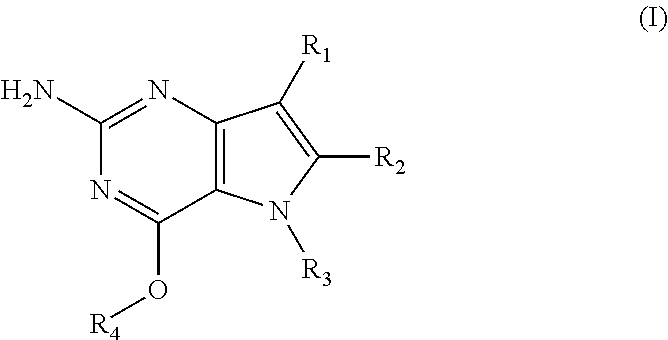
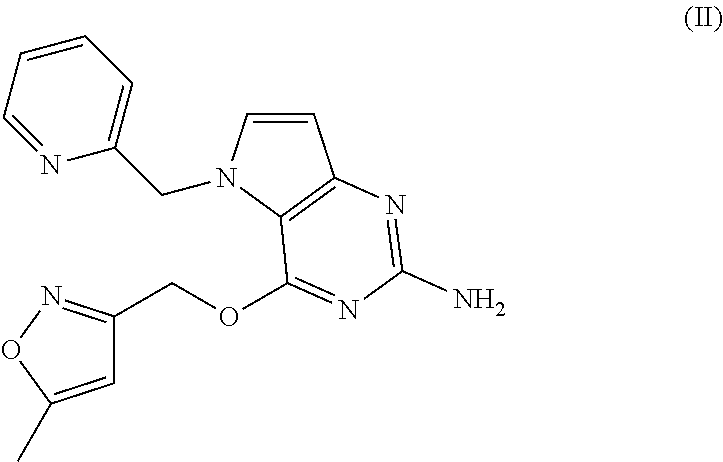



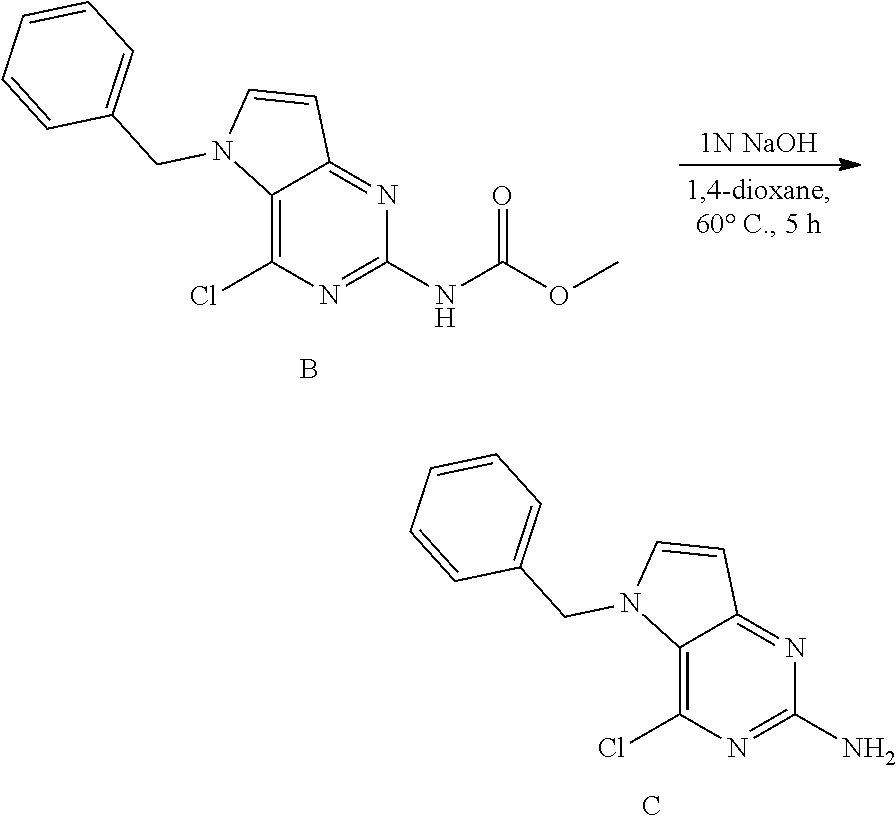
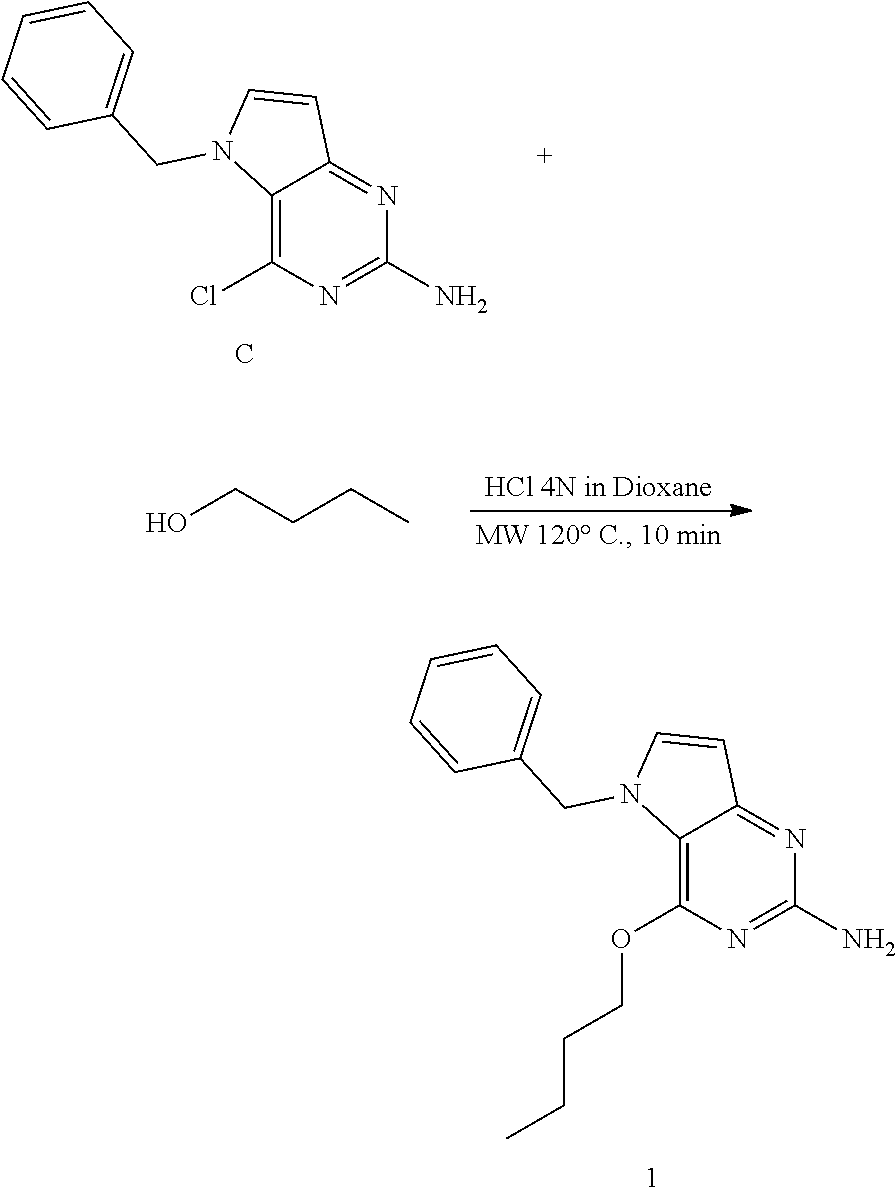

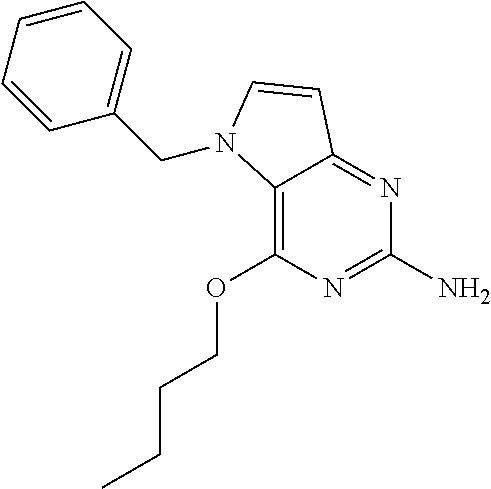
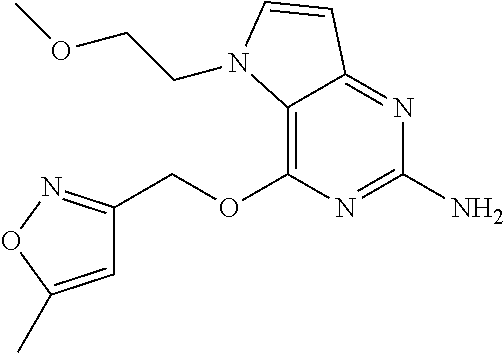
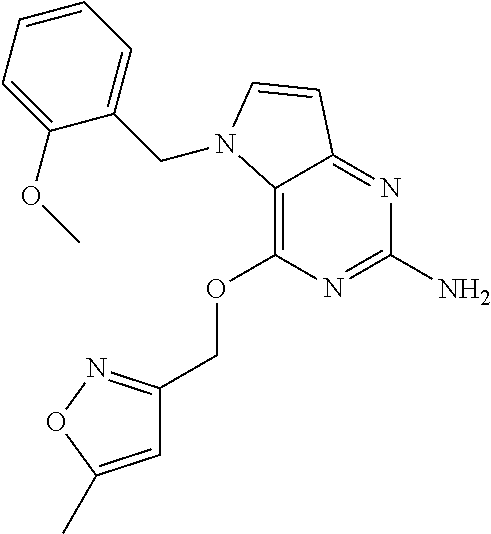
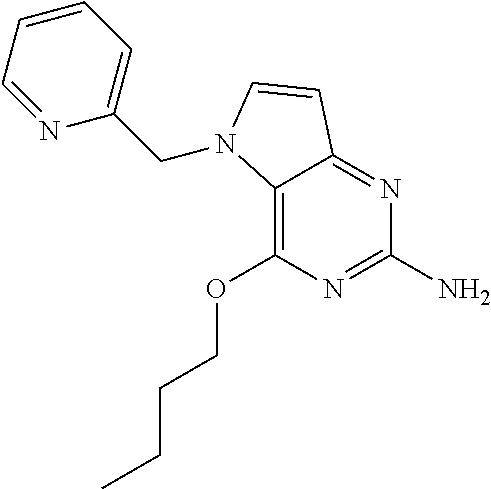
View All Diagrams
| United States Patent Application | 20200002342 |
| Kind Code | A1 |
| MC GOWAN; David Craig ; et al. | January 2, 2020 |
PYRROLO[3,2-D]PYRIMIDINE DERIVATIVES FOR THE TREATMENT OF VIRAL INFECTIONS AND OTHER DISEASES
Abstract
This invention concerns pyrrolo[3,2-d]pyrimidine derivatives, processes for their preparation, pharmaceutical compositions, and their use in treatment and/or therapy of diseases.
| Inventors: | MC GOWAN; David Craig; (BRUSSELS, BE) ; PIETERS; Serge Maria Aloysius; (Hulst, NL) ; LAST; Stefaan Julien; (Lint, BE) ; EMBRECHTS; Werner; (Beerse, BE) ; JONCKERS; Tim Hugo Maria; (Heist-op-den-Berg, BE) ; RABOISSON; Pierre Jean-Marie Bernard; (Rosieres, BE) | ||||||||||
| Applicant: |
|
||||||||||
|---|---|---|---|---|---|---|---|---|---|---|---|
| Family ID: | 48692351 | ||||||||||
| Appl. No.: | 16/441213 | ||||||||||
| Filed: | June 14, 2019 |
Related U.S. Patent Documents
| Application Number | Filing Date | Patent Number | ||
|---|---|---|---|---|
| 14392214 | Dec 23, 2015 | 10385054 | ||
| PCT/EP2014/063467 | Jun 26, 2014 | |||
| 16441213 | ||||
| Current U.S. Class: | 1/1 |
| Current CPC Class: | A61P 43/00 20180101; A61P 31/00 20180101; A61P 35/00 20180101; A61P 31/12 20180101; A61P 31/14 20180101; C07D 487/04 20130101 |
| International Class: | C07D 487/04 20060101 C07D487/04 |
Foreign Application Data
| Date | Code | Application Number |
|---|---|---|
| Jun 27, 2013 | EP | 13174108.4 |
Claims
1. A compound of formula (I): ##STR00020## or a pharmaceutically acceptable salt thereof, wherein R.sub.1 is H; R.sub.2 is H; R.sub.3 is C.sub.1-6 alkyl substituted by one or more substituents independently selected from the group consisting of aryloxy, heterocycle, halogen, aryl, alkylamino, dialkylamino, C.sub.1-6 alkyl, --CO.sub.2H, --CO.sub.2C.sub.1-6 alkyl, --CO.sub.2NH.sub.2, --CN, and C.sub.1-6 alkoxy; or R.sub.3 is an alkylaryl optionally substituted by one or more substituents independently selected from the group consisting of halogen, aryloxy, aryl, alkylamino, dialkylamino, C.sub.1-6 alkyl, --CO.sub.2H, --CO.sub.2C.sub.1-6 alkyl, --CO.sub.2NH.sub.2, --SO.sub.2NH.sub.2, --CN, and C.sub.1-6 alkoxy; and R.sub.4 is an alkylaryl substituted by one or more substituents independently selected from the group consisting of halogen, aryloxy, aryl, alkylamino, dialkylamino, C.sub.1-6 alkyl, --CO.sub.2H, --CO.sub.2C.sub.1-6 alkyl, --CO.sub.2NH.sub.2, --SO.sub.2NH.sub.2, --CN, and C.sub.1-6 alkoxy.
2. The compound of claim 1, wherein R.sub.3 is a CH.sub.2-aryl group optionally substituted by one or more substituents independently selected from the group consisting of halogen, aryloxy, aryl, alkylamino, dialkylamino, C.sub.1-6 alkyl, --CO.sub.2H, --CO.sub.2C.sub.1-6alkyl, --CO.sub.2NH.sub.2, --SO.sub.2NH.sub.2, --CN, and C.sub.1-6 alkoxy.
3. The compound of claim 1, wherein R.sub.4 is a CH.sub.2-aryl group substituted by one or more substituents independently selected from the group consisting of halogen, aryloxy, aryl, alkylamino, dialkylamino, C.sub.1-6 alkyl, --CO.sub.2H, --CO.sub.2C.sub.1-6 alkyl, --CO.sub.2NH.sub.2, --SO.sub.2NH.sub.2, --CN, and C.sub.1-6 alkoxy.
4. (canceled)
5. The compound of claim 1, selected from the group consisting of: ##STR00021## ##STR00022## or a pharmaceutically acceptable salt thereof.
6. A pharmaceutical composition comprising a compound of claim 1, or a pharmaceutically acceptable salt thereof, together with one or more pharmaceutically acceptable excipients, diluents or carriers.
7. (canceled)
8. A method of treating a viral infection in which the modulation of TLR7 is involved in a subject in need thereof, the method comprising administering to the subject a therapeutically effective amount of a compound of claim 1, or a pharmaceutically acceptable salt thereof.
9. The compound of claim 1, wherein R.sub.3 is selected from the group consisting of: ##STR00023##
10. The compound of claim 1, wherein R.sub.4 is selected from the group consisting of: ##STR00024##
11. The compound of claim 1, wherein: R.sub.3 is ##STR00025## and R.sub.4 is ##STR00026##
12. The compound of claim 1, wherein: R.sub.3 is ##STR00027## and R.sub.4 is ##STR00028##
13. The compound of claim 1, wherein: R.sub.3 is ##STR00029## and R.sub.4 is ##STR00030##
14. The compound of claim 1, wherein: R.sub.3 is ##STR00031## and R.sub.4 is ##STR00032##
15. The compound of claim 1, wherein: R.sub.3 is ##STR00033## and R.sub.4 is ##STR00034##
16. The compound of claim 1, wherein: R.sub.3 is ##STR00035## and R.sub.4 is ##STR00036##
17. The compound of claim 1, wherein: R.sub.3 is ##STR00037## and R.sub.4 is ##STR00038##
18. The compound of claim 1, wherein: R.sub.3 is ##STR00039## and R.sub.4 is ##STR00040##
19. The compound of claim 1, wherein: R.sub.3 is ##STR00041## and R.sub.4 is ##STR00042##
Description
CROSS-REFERENCE TO RELATED APPLICATIONS
[0001] This application is a continuation of Ser. No. 14/392,214, filed on Dec. 23, 2015, which is a national stage filing under USC .sctn. 371 of international application PCT/EP2014/063467 filed on Jun. 26, 2014, which claims priority to European Patent Application No. 13174108.4 filed Jun. 27, 2013, the complete disclosures of which are hereby incorporated herein by reference for all purposes.
SEQUENCE LISTING
[0002] The instant application contains a Sequence Listing which has been submitted electronically in ASCII format and is hereby incorporated by reference in its entirety. Said ASCII copy, created on Jun. 13, 2019, is named 613314-NTT-300USCON-SEQ-LISTING.TXT and is 604 bytes in size.
[0003] This invention relates to pyrrolo[3,2-d]pyrimidine derivatives, processes for their preparation, pharmaceutical compositions, and their use in treatment and/or therapy of diseases.
[0004] The present invention relates to the use of pyrrolo[3,2-d]pyrimidine derivatives, more specifically to the use of pyrrolo[3,2-d]pyrimidine derivatives in the treatment of viral infections, immune or inflammatory disorders, whereby the modulation, or agonism, of toll-like-receptors (TLRs) is involved. Toll-Like Receptors are primary transmembrane proteins characterized by an extracellular leucine rich domain and a cytoplasmic extension that contains a conserved region. The innate immune system can recognize pathogen-associated molecular patterns via these TLRs expressed on the cell surface of certain types of immune cells. Recognition of foreign pathogens activates the production of cytokines and upregulation of co-stimulatory molecules on phagocytes. This leads to the modulation of T cell behaviour.
[0005] A majority of mammalian species have between ten and fifteen types of Toll-like receptors. Thirteen TLRs (named simply TLR1 to TLR13) have been identified in humans and mice together, and equivalent forms of many of these have been found in other mammalian species. However, equivalents of certain TLR found in humans are not present in all mammals. For example, a gene coding for a protein analogous to TLR10 in humans is present in mice, but appears to have been damaged at some point in the past by a retrovirus. On the other hand, mice express TLRs 11, 12, and 13, none of which are represented in humans. Other mammals may express TLRs which are not found in humans. Other non-mammalian species may have TLRs distinct from mammals, as demonstrated by TLR14, which is found in the Takifugu pufferfish. This may complicate the process of using experimental animals as models of human innate immunity.
[0006] For reviews on toll-like receptors see the following journal articles. Hoffmann, J. A., Nature, 426, p 33-38, 2003; Akira, S., Takeda, K., and Kaisho, T., Annual Rev. Immunology, 21, p 335-376, 2003; Ulevitch, R. J., Nature Reviews: Immunology, 4, p 512-520, 2004.
[0007] Compounds indicating activity on Toll-Like receptors have been previously described such as heterocyclic derivatives in WO2000/006577, adenine derivatives in WO98/01448 and WO99/28321, and pyrimidines in WO2009/067081.
[0008] In the treatment of certain viral infections, regular injections of interferon (IFN-alfa) can be administered, as is the case for hepatitis C virus (HCV). Orally available small molecule IFN inducers offer the potential advantages of reduced immunogenicity and convenience of administration. Thus, novel IFN inducers are potentially effective new class of drugs for the treatment of viral infections. For an example in the literature of a small molecule IFN inducer having antiviral effect see De Clercq, E.; Descamps, J.; De Somer, P. Science 1978, 200, 563-565.
[0009] Interferon .alpha. is also given to patients in combination with other drugs in the treatment of certain types of cancer. TLR 7/8 agonists are also of interest as vaccine adjuvants because of their ability to induce pronounced Th1 response.
[0010] However, there exists a strong need for novel Toll-Like receptor modulators having preferred selectivity, and an improved safety profile compared to the compounds of the prior art.
[0011] In accordance with the present invention a compound of formula (I) is provided
##STR00001##
[0012] and their pharmaceutically acceptable salt, solvate or polymorph thereof wherein
[0013] R.sub.1 is H, fluorine or methyl;
[0014] R.sub.2 is H, halogen or C.sub.1-3 alkyl;
[0015] R.sub.3 is C.sub.1-6 alkyl optionally substituted by one or more substituents independently selected from aryloxy, heterocycle, halogen, aryl, alkylamino, dialkylamino, C.sub.1-6 alkyl, carboxylic acid, carboxylic ester, carboxylic amide, nitrile, or C.sub.1-6 alkoxy;
[0016] or wherein
[0017] R.sub.3 is an alkylaryl optionally substituted by one or more substituents independently selected from halogen, aryloxy, aryl, alkylamino, dialkylamino, C.sub.1-6 alkyl, carboxylic acid, carboxylic ester, carboxylic amide, sulfonamide, nitrile, or C.sub.1-6 alkoxy;
[0018] R.sub.4 is C.sub.1-6 alkyl optionally substituted by one or more substituents independently selected from hydroxyl, C.sub.1-6 alkyl, C.sub.3-7 cycloalkyl, C.sub.2-6 alkenyl or aryl optionally further substituted by C.sub.1-6 alkyl, and C.sub.3-7 cycloalkyl optionally further substituted by C.sub.1-6 alkyl;
[0019] or wherein
[0020] R.sub.4 is an alkylaryl optionally substituted by one or more substituents independently selected from halogen, aryloxy, aryl, alkylamino, dialkylamino, C.sub.1-6 alkyl, carboxylic acid, carboxylic ester, carboxylic amide, sulfonamide, nitrile, or C.sub.1-6 alkoxy.
[0021] Preferred compounds are those of formula (I) wherein R.sub.3 is a CH.sub.2-aryl group (substituted or unsubstituted), and R.sub.1, R.sub.2, and R.sub.4 are described as above.
[0022] In a second embodiment are the compounds of formula (I) wherein R.sub.3 and R.sub.4 are both CH.sub.2-aryl groups optionally further substituted as described above, and R.sub.1, and R.sub.2 are as described as above.
[0023] Other preferred embodiments are those of formula (I) wherein R.sub.1 is fluorine, R.sub.2 is hydrogen, and R.sub.3 and R.sub.4 are described as above.
[0024] The most preferred compound is compound of formula (II) having the following chemical structure:
##STR00002##
[0025] The compounds of formula (I) and (II) and their pharmaceutically acceptable salt, solvate or polymorph thereof have activity as pharmaceuticals, in particular as modulators of Toll-Like Receptor (especially TLR7) activity.
[0026] In a further aspect the present invention provides a pharmaceutical composition comprising a compound of formula (I) or (II) or a pharmaceutically acceptable salt, solvate or polymorph thereof together with one or more pharmaceutically acceptable excipients, diluents or carriers.
[0027] Furthermore a compound of formula (I) or (II) or a pharmaceutically acceptable salt, solvate or polymorph thereof according to the current invention, or a pharmaceutical composition comprising said compound of formula (I) or (II) or a pharmaceutically acceptable salt, solvate or polymorph thereof can be used as a medicament.
[0028] Another aspect of the invention is that a compound of formula (I) or (II) or a pharmaceutically acceptable salt, solvate or polymorph thereof, or said pharmaceutical composition comprising said compound of formula (I) or (II) or a pharmaceutically acceptable salt, solvate or polymorph thereof can be used accordingly in the treatment of any disorder in which the modulation of TLR7 is involved.
[0029] The term "alkyl" refers to a straight-chain or branched-chain saturated aliphatic hydrocarbon containing the specified number of carbon atoms.
[0030] The term "halogen" refers to fluorine, chlorine, bromine or iodine.
[0031] The term "alkylaryl" refers to a straight-chain or branched-chain saturated aliphatic hydrocarbon containing the specified number of carbon atoms substituted by an aryl wherein "aryl" is defined as below.
[0032] The term "alkenyl" refers to an alkyl as defined above consisting of at least two carbon atoms and at least one carbon-carbon double bond.
[0033] The term "cycloalkyl" refers to a carbocyclic ring containing the specified number of carbon atoms.
[0034] The term "alkoxy" refers to an alkyl (carbon and hydrogen chain) group singular bonded to oxygen like for instance a methoxy group or ethoxy group.
[0035] The term "aryl" means an aromatic ring structure optionally comprising one or two heteroatoms selected from N, O and S, in particular from N and O. Said aromatic ring structure may have 5, 6 or 7 ring atoms. In particular, said aromatic ring structure may have 5 or 6 ring atoms.
[0036] The term "aryloxy" refers to an aromatic ring structure. Said aromatic group is singularly bonded to oxygen.
[0037] The term "heterocycle" refers to molecules that are saturated or partially saturated and include tetrahydrofuran, dioxane or other cyclic ethers. Heterocycles containing nitrogen include, for example azetidine, morpholine, piperidine, piperazine, pyrrolidine, and the like. Other heterocycles include, for example, thiomorpholine, dioxolinyl, and cyclic sulfones.
[0038] Pharmaceutically acceptable salts of the compounds of formula (I) and (II) include the acid addition and base salts thereof. Suitable acid addition salts are formed from acids which form non-toxic salts. Suitable base salts are formed from bases which form non-toxic salts.
[0039] The compounds of the invention may also exist in unsolvated and solvated forms. The term "solvate" is used herein to describe a molecular complex comprising the compound of the invention and one or more pharmaceutically acceptable solvent molecules, for example, ethanol.
[0040] The term "polymorph" refers to the ability of the compound of the invention to exist in more than one form or crystal structure.
[0041] The compounds of the present invention may be administered as crystalline or amorphous products. They may be obtained for example as solid plugs, powders, or films by methods such as precipitation, crystallization, freeze drying, spray drying, or evaporative drying. They may be administered alone or in combination with one or more other compounds of the invention or in combination with one or more other drugs. Generally, they will be administered as a formulation in association with one or more pharmaceutically acceptable excipients. The term "excipient" is used herein to describe any ingredient other than the compound(s) of the invention. The choice of excipient depends largely on factors such as the particular mode of administration, the effect of the excipient on solubility and stability, and the nature of the dosage form.
[0042] The compounds of the present invention or any subgroup thereof may be formulated into various pharmaceutical forms for administration purposes. As appropriate compositions there may be cited all compositions usually employed for systemically administering drugs. To prepare the pharmaceutical compositions of this invention, an effective amount of the particular compound, optionally in addition salt form, as the active ingredient is combined in intimate admixture with a pharmaceutically acceptable carrier, which carrier may take a wide variety of forms depending on the form of preparation desired for administration. These pharmaceutical compositions are desirably in unitary dosage form suitable, for example, for oral, rectal, or percutaneous administration. For example, in preparing the compositions in oral dosage form, any of the usual pharmaceutical media may be employed such as, for example, water, glycols, oils, alcohols and the like in the case of oral liquid preparations such as suspensions, syrups, elixirs, emulsions, and solutions; or solid carriers such as starches, sugars, kaolin, diluents, lubricants, binders, disintegrating agents and the like in the case of powders, pills, capsules, and tablets. Because of their ease in administration, tablets and capsules represent the most advantageous oral dosage unit forms, in which case solid pharmaceutical carriers are obviously employed. Also included are solid form preparations that can be converted, shortly before use, to liquid forms. In the compositions suitable for percutaneous administration, the carrier optionally comprises a penetration enhancing agent and/or a suitable wetting agent, optionally combined with suitable additives of any nature in minor proportions, which additives do not introduce a significant deleterious effect on the skin. Said additives may facilitate the administration to the skin and/or may be helpful for preparing the desired compositions. These compositions may be administered in various ways, e.g., as a transdermal patch, as a spot-on, as an ointment. The compounds of the present invention may also be administered via inhalation or insufflation by means of methods and formulations employed in the art for administration via this way. Thus, in general the compounds of the present invention may be administered to the lungs in the form of a solution, a suspension or a dry powder.
[0043] It is especially advantageous to formulate the aforementioned pharmaceutical compositions in unit dosage form for ease of administration and uniformity of dosage. Unit dosage form as used herein refers to physically discrete units suitable as unitary dosages, each unit containing a predetermined quantity of active ingredient calculated to produce the desired therapeutic effect in association with the required pharmaceutical carrier. Examples of such unit dosage forms are tablets (including scored or coated tablets), capsules, pills, powder packets, wafers, suppositories, injectable solutions or suspensions and the like, and segregated multiples thereof.
[0044] Those of skill in the treatment of infectious diseases will be able to determine the effective amount from the test results presented hereinafter. In general it is contemplated that an effective daily amount would be from 0.01 mg/kg to 50 mg/kg body weight, more preferably from 0.1 mg/kg to 10 mg/kg body weight. It may be appropriate to administer the required dose as two, three, four or more sub-doses at appropriate intervals throughout the day. Said sub-doses may be formulated as unit dosage forms, for example, containing 1 to 1000 mg, and in particular 5 to 200 mg of active ingredient per unit dosage form.
[0045] The exact dosage and frequency of administration depends on the particular compound of formula (I) used, the particular condition being treated, the severity of the condition being treated, the age, weight and general physical condition of the particular patient as well as other medication the individual may be taking, as is well known to those skilled in the art. Furthermore, it is evident that the effective amount may be lowered or increased depending on the response of the treated subject and/or depending on the evaluation of the physician prescribing the compounds of the instant invention. The effective amount ranges mentioned above are therefore only guidelines and are not intended to limit the scope or use of the invention to any extent.
EXPERIMENTAL SECTION
##STR00003##
[0047] Compounds of type A in scheme 1 can be functionalized with alcohols using Mitsunobu conditions in a polar aprotic solvent, for example THF. The cleavage of the methyl carbamate was performed under basic conditions in 1,4-dioxane to form intermediate C. The displacement of the chlorine in C was performed with an alcohol and a base (e.g. NaH) in a polar aprotic solvent (e.g. NMP) to form compounds of the type D.
Preparation of Intermediate A
##STR00004##
[0049] 3-Amino-2-ethoxycarbonylpyrrole hydrochloride (25.8 g, 135.3 mmol) was partitioned between dichloromethane and sat. NaHCO.sub.3. The organic layer was dried over MgSO.sub.4, the solids were removed via filtration, and the solvent of the filtrate evaporated to dryness. The residue was dissolved in methanol (500 mL) together with 1,3-bis(methoxycarbonyl)-2-methyl-2-thiopseudourea (32.1 g, 156 mmol) and acetic acid (39 mL, 677 mmol) and stirred 1 hour at room temperature. A precipitate appeared and stirring was continued overnight. Sodium methoxide (73.1 g, 1353 mmol) was added. An exothermic reaction was observed and the reaction mixture was stirred overnight. The mixture was brought to pH 5 with acetic acid and the precipitate was isolated by filtration, triturated on the filter with water (2.times.350 mL), acetonitrile (350 mL) and diisopropylether (350 mL). The obtained methyl N-(4-hydroxy-5H-pyrrolo-[3,2-d]pyrimidin-2-yl)carbamate was dried in the oven.
[0050] methyl N-(4-hydroxy-5H-pyrrolo[3,2-d]pyrimidin-2-yl)carbamate (25 g, 120 mmol) was dispensed in 350 mL acetonitrile in a 500 mL multi neck flask equipped with an overhead stirrer (300 rpm) at room temperature. POCl.sub.3 (22.1 mL, 238.2 mmol) was added and then the reaction mixture was heated to 70.degree. C. while stirring. Diisopropylethylamine (41.4 mL, 240.2 mmol) was added dropwise via a syringe pump at a flow of 0.2 mL/min.
[0051] The reaction mixture was cooled to room temperature and poured into a stirred solution of sodium acetate (78.8 g, 961 mmol) in water (500 mL) at 45.degree. C. The organics were evaporated and the remaining liquid was stirred and cooled over an ice bath. The formed solid was isolated by filtration, washed with acetonitrile and triturated with diisopropylether to afford intermediate A, dried under vacuum. LC-MS m/z=227 (M+H)
Preparation of Intermediate B
Method 1.
##STR00005##
[0053] To a suspension of A (500 mg, 2.2 mmol), benzylalcohol (0.28 mL, 2.6 mmol) and triphenylphosphine (0.69 g, 2.6 mmol) in anhydrous THF (15 mL) was added DIAD (0.64 mL, 3.3 mmol) at room temperature. The reaction mixture was stirred at room temperature for 30 minutes. The mixture was concentrated under reduced pressure. The product was purified via silica gel column chromatography using a heptanes to ethyl acetate gradient; 100-0 to 90-10. The product fractions were collected and concentrated under reduced pressure. The product was triturated in diisopropylether, isolated by filtration and dried under vacuum to afford B as a pale yellow solid. LC-MS m/z=317 (M+H)
Method 2 with Resin Bound Triphenylphosphine.
[0054] To a suspension of A (700 mg, 3.1 mmol), benzylalcohol (0.39 mL, 3.7 mmol) and triphenylphosphine resin (2.6 g, 7.7 mmol) in anhydrous THF (21 mL) was added DIAD (0.90 mL, 4.6 mmol) at room temperature. The reaction mixture was stirred at room temperature for 1 h. The mixture was filtered over packed decalite and washed with methanol. The filtrate was concentrated in vacuo. The product was triturated in diisopropylether, isolated by filtration and dried under vacuum to afford a pale yellow solid, B. LC-MS m/z=317 (M+H)
Preparation of Intermediate C
##STR00006##
[0056] B (738 mg, 2.3 mmol) was dissolved in 1,4-dioxane (11 mL) in a 50 mL glass tube and NaOH (5.6 mL, 1N a.q.) was added. The mixture was heated to 60.degree. C. for 5 h. The mixture was cooled and concentrated in vacuo. The residue was treated with water and the precipitate was isolated by filtration and dried under vacuum to afford C as a solid. The product was used as such in the next step. LC-MS m/z=259 (M+H)
Preparation of 1 and 2
Method 1
##STR00007##
[0058] Intermediate C (240 mg, 0.93 mmol), n-butylalcohol (3.2 mL, 35 mmol), and 4N HCl in dioxane (0.46 mL, 1.9 mmol) was placed into a 7 mL microwave vial. The vial was sealed and the mixture was heated in the microwave at 120.degree. C. for 10 minutes. The mixture was cooled and concentrated in vacuo. The residue was neutralized with sat. NaHCO.sub.3 solution and extracted with dichloromethane. The organic layer was separated, dried (MgSO.sub.4), the solids were removed by filtration and the filtrate was concentrated under reduced pressure. The product was purified via silica gel column chromatography using a dichloromethane-methanol, 100-0 to 95-5 gradient. The best fractions were collected and concentrated under reduced pressure. The product was triturated in diisopropylether and the solid was isolated by filtration and dried under vacuum to afford 1 as a white solid.
Method 2.
##STR00008##
[0060] Intermediate C.sub.2 (250 mg, 1.1 mmol), and 3-hydroxymethyl-5-methylisoxazole (0.16 mL, 1.65 mmol) were dissolved in NMP (3 mL) in a 7 mL vial. The mixture was cooled on a ice bath and NaH (66 mg, 1.65 mmol, 60% dispersion in mineral oil) was added under N.sub.2 and the mixture was stirred at 0-5.degree. C. for 30 minutes and then allowed to warm to room temperature and continued stirring for 2 h. Then crude reaction mixture was purified by preparatory HPLC (Stationary phase: RP Vydac Denali C18 10 .mu.m, 200 g, 5 cm), mobile phase: 0.25% NH.sub.4OAc solution in water, CH.sub.3CN), the desired fractions were collected and concentrated in vacuo. The product was crystallized from CH.sub.3CN, isolated by filtration and dried under vacuum to afford a white solid, 2.
TABLE-US-00001 TABLE 1 Compounds of formula (I) and corresponding analytical data. Compounds were prepared according to the methods described in the experimental section. LC Method, LC-MS Mass # STRUCTURE .sup.1H NMR Rt (min) Found (M + H) 1 ##STR00009## .sup.1H NMR (400 MHz, DMSO-d.sub.6) .delta. ppm 0.85 (t, J = 7.37 Hz, 3 H) 1.26 (dq, J = 15.02, 7.39 Hz, 2 H) 1.56-1.63 (m, 2 H) 4.30 (t, J = 6.38 Hz, 2 H) 5.39 (s, 2 H) 5.72 (s, 2 H) 6.08 (d, J = 3.08 Hz, 1 H) 7.03-7.08 (m, 2 H) 7.19- 7.25 (m, 1 H) 7.26-7.32 (m, 2 H) 7.48 (d, J = 3.08 Hz, 1 H) B, 1.98 297 2 ##STR00010## .sup.1H NMR (400 MHz, DMSO-d.sub.6) .delta. ppm 2.41 (d, J = 0.66 Hz, 3 H) 3.17 (s, 3 H) 3.57 (t, J = 5.50 Hz, 2 H) 4.29 (t, J = 5.50 Hz, 2 H) 5.50 (s, 2 H) 5.82 (s, 2 H) 6.03 (d, J = 2.86 Hz, 1 H) 6.37 (d, J = 0.88 Hz, 1 H) 7.35 (d, J = 2.86 Hz, 1 H) A, 0.69 304 3 ##STR00011## .sup.1H NMR (400 MHz, DMSO-d.sub.6) .delta. ppm 2.33-2.38 (m, 3 H) 3.79 (s, 3 H) 5.34 (s, 2 H) 5.38 (s, 2 H) 5.75 (s, 1 H) 5.86 (s, 2 H) 6.12 (d, J = 3.08 Hz, 1 H) 6.40-6.47 (m, 1 H) 6.78 (td, J = 7.48, 0.66 Hz, 1 H) 7.00 (d, J = 7.92 Hz, 1 H) 7.24 (td, J = 7.80, 1.80 Hz, 1 H) 7.43 (d, J = 2.86 Hz, 1 H) B, 1.62 366 4 ##STR00012## .sup.1H NMR (400 MHz, DMSO-d.sub.6) .delta. ppm 0.77 (t, J = 7.4 Hz, 3 H), 1.12 (dq, J = 15.0, 7.4 Hz, 2 H), 1.40- 1.50 (m, 2 H), 4.21 (t, J = 6.4 Hz, 2 H), 5.49 (s, 2 H), 5.73 6 (s, 2 H), 6.11 (d, J = 2.9 Hz, 1 H), 6.65 (d, J = 7.9 Hz, 1 H), 7.21-7.28 (m, 1 H), 7.47 (d, J = 3.1 Hz, 1 H), 7.69 (td, J = 7.7, 1.8 Hz, 1 H), 8.47-8.53 (m, 1 H) A, 0.81 298 5 ##STR00013## .sup.1H NMR (400 MHz, DMSO-d.sub.6 ) .delta. ppm 2.35 (s, 3 H) 5.37 (s, 2 H) 5.47 (s, 2 H) 5.84-5.90 (m, 3 H) 6.14 (d, J = 2.86 Hz, 1 H) 6.72 (d, J = 7.92 Hz, 1 H) 7.24 (dd, J = 6.93, 4.95 Hz, 1 H) 7.52 (d, J = 3.08 Hz, 1 H) 7.65 (td, J = 7.70, 1.76 Hz, 1 H) 8.47 (d, J = 4.18 Hz, 1 H) B, 1.29 337 6 ##STR00014## .sup.1H NMR (400 MHz, DMSO-d.sub.6) .delta. ppm 2.57 (s, 3 H) 5.45 (s, 2 H) 5.51 (s,2 H) 5.85 (s, 2 H) 6.13 (d, J = 2.86 Hz, 1 H) 6.85 (d, J = 7.70 Hz, 1 H) 7.22 (dd, J = 7.04, 5.06 Hz, 1 H) 7.52 (d, J = 3.08 Hz, 1 H) 7.64 (td, J = 7.65, 1.65 Hz, 1 H) 8.43 (d, J = 4.18 Hz, 1 H) B, 1.14 338 7 ##STR00015## .sup.1H NMR (400 MHz, DMSO-d.sub.6) .delta. ppm 2.36 (s, 3 H) 3.74 (s, 3 H) 3.71 (s, 3 H) 5.29 (s, 2 H) 5.40 (s, 2 H) 5.85 (s, 2 H) 5.93 (s, 1 H) 6.12 (d, J = 3.08 Hz, 1 H) 6.29 (d, J = 7.92 Hz, 1 H) 7.11 (d, J = 7.92 Hz, 1 H) 7.50 (d, J = 3.08 Hz, 1 H) B, 1.45 397 8 ##STR00016## .sup.1H NMR (400 MHz, DMSO-d.sub.6) .delta. ppm 2.36 (s, 3 H) 3.80 (s, 3 H) 5.31 (s, 2 H) 5.48 (s, 2 H) 5.75- 5.81 (m, 3 H) 6.07 (d, J = 2.86 Hz, 1 H) 7.25 (dd, J = 8.25, 4.73 Hz, 1 H) 7.36-7.41 (m, 2 H) 7.90 (dd, J = 4.73, 0.99 Hz, 1 H) A, 0.72 367 9 ##STR00017## .sup.1H NMR (400 MHz, DMSO-d.sub.6) .delta. ppm 2.23 (d, J = 1.10 Hz, 3 H) 3.77 (s, 3 H) 5.32 (s, 2 H) 5.45 (s, 2 H) 5.77 (s, 2 H) 6.07 (d, J = 2.86 Hz, 1 H) 6.79 (d, J = 1.10 Hz, 1 H) 7.21 (dd, J = 8.25, 4.73 Hz, 1 H) 7.33 (dd, J = 8.36, 1.32 Hz, 1 H) 7.37 (d, J = 2.86 Hz, 1 H) 7.88 (dd, J = 4.73, 1.21 Hz, 1 H) B, 1.26 367 10 ##STR00018## .sup.1H NMR (400 MHz, DMSO-d.sub.6) .delta. ppm 2.34-2.41 (m, 3 H) 5.49 (s, 2 H) 5.58 (s, 2 H) 5.88 (s, 2 H) 6.15 (d, J = 2.86 Hz, 1 H) 6.72 (d, J = 7.92 Hz, 1 H) 7.20-7.25 (m, 1 H) 7.43 (d, J = 1.10 Hz, 1 H) 7.52 (d, J = 2.86 Hz, 1 H) 7.63 (td, J = 7.70, 1.76 Hz, 1 H) 8.46 (dd, J = 4.73, 0.77 Hz, 1 H) B, 1.28 353 11 ##STR00019## .sup.1H NMR (400 MHz, DMSO-d.sub.6) .delta. ppm 2.24 (s, 3 H) 5.39 (s, 2 H) 5.43 (s, 2 H) 5.85 (s, 2 H) 6.13 (d, J = 2.86 Hz, 1 H) 6.76 (d, J = 7.70 Hz, 1 H) 6.81 (s, 1 H) 7.21 (dd, J = 6.93, 5.17 Hz, 1 H) 7.52 (d, J = 2.86 Hz, 1 H) 7.62 (td, J = 7.65, 1.43 Hz, 1 H) 8.40 - 8.45 (m, 1 H) B, 1.18 337
Analytical Methods.
LCMS General Procedure
[0061] The High Performance Liquid Chromatography (HPLC) measurement was performed using a LC pump, a diode-array (DAD) or a UV detector and a column as specified in the respective methods. If necessary, additional detectors were included (see table of methods below).
[0062] Flow from the column was brought to the Mass Spectrometer (MS) which was configured with an atmospheric pressure ion source. It is within the knowledge of the skilled person to set the tune parameters (e.g. scanning range, dwell time . . . ) in order to obtain ions allowing the identification of the compound's nominal monoisotopic molecular weight (MW). Data acquisition was performed with appropriate software.
[0063] Compounds are described by their experimental retention times (Rt) and ions. If not specified differently in the table of data, the reported molecular ion corresponds to the [M+H]+(protonated molecule) and/or [M-H]- (deprotonated molecule). In case the compound was not directly ionizable the type of adduct is specified (i.e. [M+NH.sub.4]+, [M+HCOO]-, etc. . . . ). For molecules with multiple isotopic patterns (Br, Cl . . . ), the reported value is the one obtained for the lowest isotope mass. All results were obtained with experimental uncertainties that are commonly associated with the method used.
[0064] Hereinafter, "SQD" means Single Quadrupole Detector, "MSD" Mass Selective Detector, "RT" room temperature, "BEH" bridged ethylsiloxane/silica hybrid, "DAD" Diode Array Detector, "HSS" High Strength silica, "Q-Tof" Quadrupole Time-of-flight mass spectrometers, "CLND", ChemiLuminescent Nitrogen Detector, "ELSD" Evaporative Light Scanning Detector,
[0065] LC-MS Method codes (Flow expressed in mL/min; column temperature (Col T) in .degree. C.; Run time in minutes).
TABLE-US-00002 Method Flow code Instrument Column Mobile phase Gradient Col T Run time A Waters: Waters: A: 10 mM From 95% A 0.8 2 Acquity .RTM. BEH C18 CH.sub.3COONH.sub.4 to 5% A in 55 UPLC .RTM.-DAD (1.7 .mu.m, in 95% H.sub.2O + 1.3 min, held and SQD 2.1 * 50 mm) 5% CH.sub.3CN for 0.7 min. B: CH.sub.3CN
Biological Activity of Compounds of Formula (I) and (II)
Description of Biological Assays
Assessment of TLR7 and TLR8 Activity
[0066] The ability of compounds to activate human TLR7 and/or TLR8 was assessed in a cellular reporter assay using HEK293 cells transiently transfected with a TLR7 or TLR8 expression vector and NF.kappa.B-luc reporter construct.
[0067] Briefly, HEK293 cells were grown in culture medium (DMEM supplemented with 10% FCS and 2 mM Glutamine). For transfection of cells in 15 cm dishes, cells were detached with Trypsin-EDTA, transfected with a mix of CMV-TLR7 or TLR8 plasmid (1700 ng), NF.kappa.B-luc plasmid (850 ng) and a transfection reagent and incubated for 48 h at 37.degree. C. in a humidified 5% CO.sub.2 atmosphere. Transfected cells were then washed in PBS, detached with Trypsin-EDTA and resuspended in medium to a density of 1.25.times.10.sup.5 cells/mL. Forty microliters of cells were then dispensed into each well in 384-well plates, where 200 nL of compound in 100% DMSO was already present. Following 6 hours incubation at 37.degree. C., 5% CO.sub.2, the luciferase activity was determined by adding 15 .mu.L of Steady Lite Plus substrate (Perkin Elmer) to each well and readout performed on a ViewLux ultraHTS microplate imager (Perkin Elmer). Dose response curves were generated from measurements performed in quadruplicates. Lowest effective concentrations (LEC) values, defined as the concentration that induces an effect which is at least two fold above the standard deviation of the assay, were determined for each compound.
[0068] Compound toxicity was determined in parallel using a similar dilution series of compound with 40 .mu.L per well of cells transfected with the CMV-TLR7 construct alone (1.25.times.10.sup.5 cells/mL), in 384-well plates. Cell viability was measured after 6 hours incubation at 37.degree. C., 5% CO.sub.2 by adding 15 .mu.L of ATP lite (Perkin Elmer) per well and reading on a ViewLux ultraHTS microplate imager (Perkin Elmer). Data was reported as 0050.
[0069] In parallel, a similar dilution series of compound was used (200 nL of compound in 100% DMSO) with 40 .mu.L per well of cells transfected with NF.kappa.B-luc reporter construct alone (1.25.times.10.sup.5 cells/mL). Six hours after incubation at 37.degree. C., 5% CO.sub.2, the luciferase activity was determined by adding 15 .mu.L of Steady Lite Plus substrate (Perkin Elmer) to each well and readout performed on a ViewLux ultraHTS microplate imager (Perkin Elmer). Counterscreen data is reported as LEC.
Activation of ISRE Promoter Elements
[0070] The potential of compounds to induce IFN-I was also evaluated by measuring the activation of interferon-stimulated responsive elements (ISRE) by conditioned media from PBMC. The ISRE element of sequence GAAACTGAAACT (SEQ ID NO: 1) is highly responsive to the STAT1-STAT2-IRF9 transcription factor, activated upon binding of IFN-I to their receptor IFNAR (Clontech, PT3372-5W). The plasmid pISRE-Luc from Clontech (ref. 631913) contains 5 copies of this ISRE element, followed by the firefly luciferase ORF. A HEK293 cell line stably transfected with pISRE-Luc (HEK-ISREluc) was established to profile the conditioned PBMC cell culture media.
[0071] Briefly, PBMCs were prepared from buffy coats of at least two donors using a standard Ficoll centrifugation protocol. Isolated PBMCs were resuspended in RPMI medium supplemented with 10% human AB serum and 2.times.10.sup.5 cells/well were dispensed into 384-well plates containing compounds (70 .mu.L total volume). After overnight incubation, 10 .mu.L of supernatant was transferred to 384-well plates containing 5.times.10.sup.3 HEK-ISREluc cells/well in 30 .mu.L (plated the day before). Following 24 hours of incubation, activation of the ISRE elements was measured by assaying luciferase activity using 40 .mu.L/well Steady Lite Plus substrate (Perkin Elmer) and measured with ViewLux ultraHTS microplate imager (Perkin Elmer). The stimulating activity of each compound on the HEK-ISREluc cells was reported as LEC value, defined as the compound concentration applied to the PBMCs resulting in a luciferase activity at least two fold above the standard deviation of the assay. The LEC in turn indicates the degree of ISRE activation on transfer of a defined amount of PBMC culture medium. Recombinant interferon .alpha.-2a (Roferon-A) was used as a standard control compound.
TABLE-US-00003 TABLE 2 Activity of compounds of formula (I). All compounds demonstrated a CC.sub.50 >24 .mu.M. Human TLR 7 Human TLR 8 HEK-ISRE luc # (LEC) .mu.M (LEC) .mu.M (LEC) .mu.M 1 0.6 >25 0.4 2 2.7 >25 0.5 3 0.1 >25 0.03 4 1.4 >25 0.6 5 0.4 >25 0.1 6 3.9 >25 2 7 0.08 >25 0.03 8 0.03 >25 0.01 9 0.07 >25 NA 10 0.5 >25 NA 11 0.6 >25 NA NA = not available
Sequence CWU 1
1
1112DNAArtificial SequenceDescription of Artificial Sequence
Synthetic oligonucleotide 1gaaactgaaa ct 12












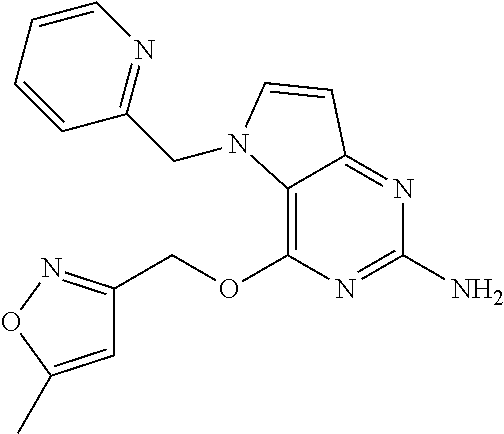
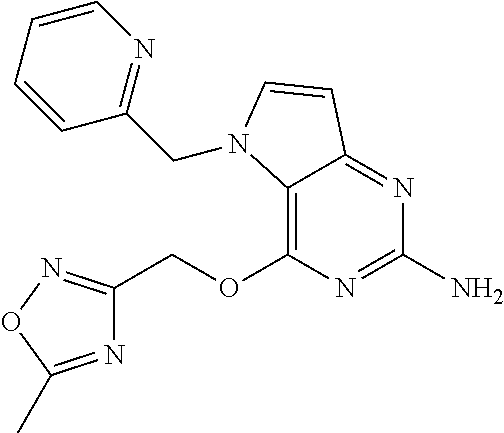
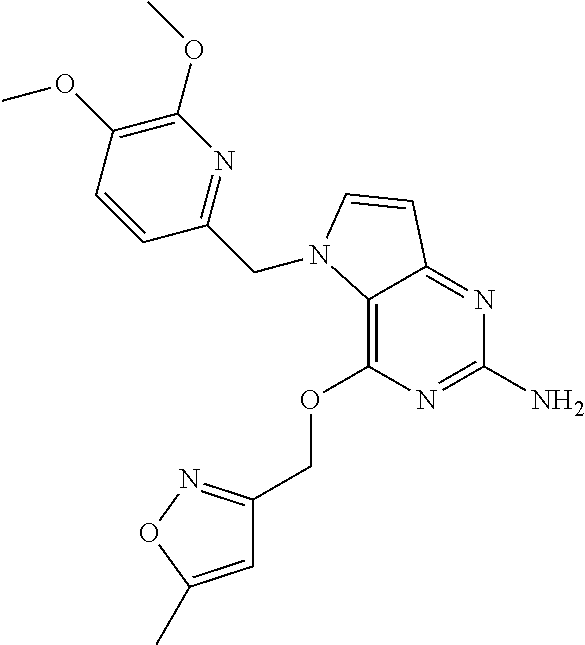
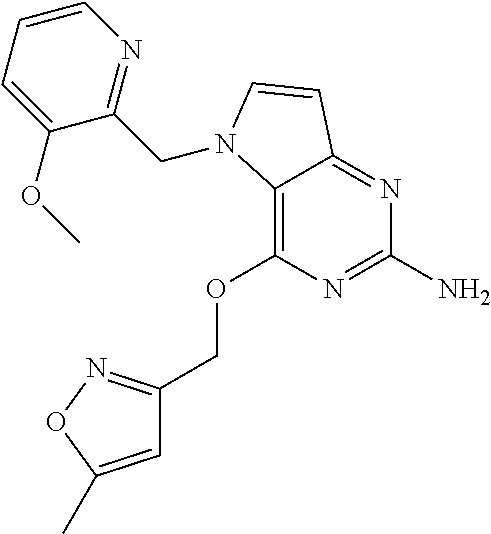

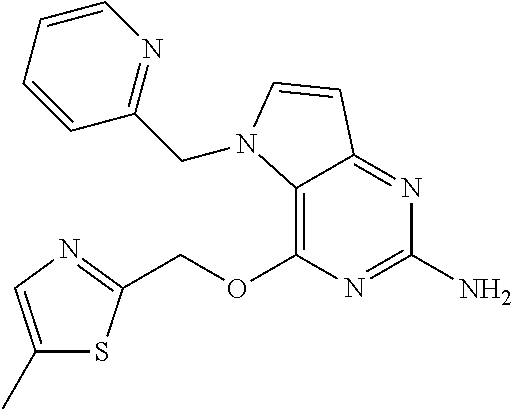
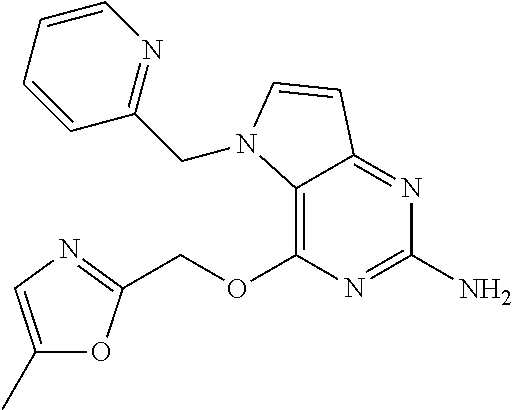





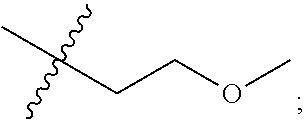
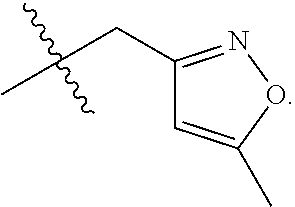

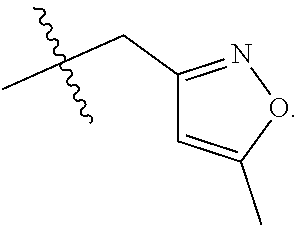
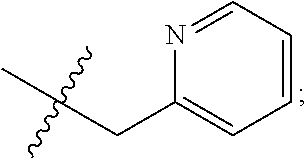




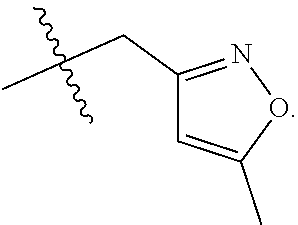
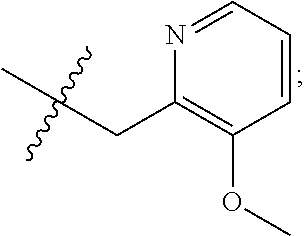


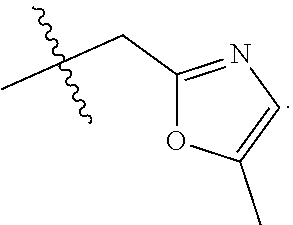

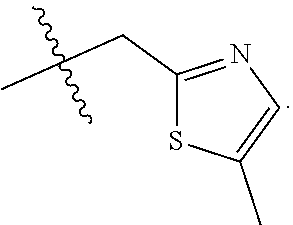

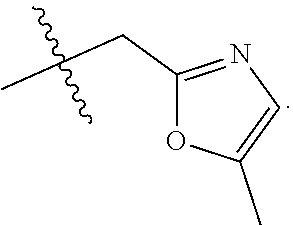
S00001
XML
uspto.report is an independent third-party trademark research tool that is not affiliated, endorsed, or sponsored by the United States Patent and Trademark Office (USPTO) or any other governmental organization. The information provided by uspto.report is based on publicly available data at the time of writing and is intended for informational purposes only.
While we strive to provide accurate and up-to-date information, we do not guarantee the accuracy, completeness, reliability, or suitability of the information displayed on this site. The use of this site is at your own risk. Any reliance you place on such information is therefore strictly at your own risk.
All official trademark data, including owner information, should be verified by visiting the official USPTO website at www.uspto.gov. This site is not intended to replace professional legal advice and should not be used as a substitute for consulting with a legal professional who is knowledgeable about trademark law.